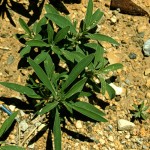Kochia , Burningbush
Bassia scoparia (L.) A.J. Scott
Chenopodiaceae
Description
Kochia is an introduced, annual forb growing from 2 to 5 feet or 0.6 to 1.5 m tall beginning in late spring. It belongs to the Chenopodiaceae (Goosefoot) family. Kochia forms in a pyramidal or rounded shape from a taproot system that reaches around 8 ft or 2.4 m in depth. Stems are erect, much branched, and leafy. Leaves, arranged alternately on the stems, turn bright red with age. The leaves are simple, linear to narrowly ovate, may have hairs, and reach about 5.5 cm long. Kochia’s flowers are inconspicuous, grow on a spike, and are green leaf-like bracts that are surrounded by tufts of hair. It has an utricle fruit that houses a single, oval, and brown to black seed. When it is mature, Kochia breaks at the base and becomes a tumbleweed which aids in seed dispersal. Interest in the plant as a feed source has been high because it can produce the same amount of forage per acre as alfalfa with half the water; hence, the plant is often called "poor man's alfalfa." During early growth, Kochia is palatable and has high forage value for all species of livestock which can be grazed or hayed. It provides shelter for wildlife, and the seeds are consumed by songbird and game bird species. Foliage is also consumed by deer and pronghorn.Habitat
An annual plant originating in Eurasia, Kochia was introduced into America in the early 1900s and is highly invasive. Its appearance was first recorded in Texas during the late 1940s. Found throughout most of the United States, it occurs locally on disturbed sites, gardens, roadsides, pasturelands, rangelands, and old fields. Kochia is tolerant of drought, salinity, and harsh soil conditions. It is highly suited for semi-arid and arid environments.Toxic Agent
The plant contains several agents that could contribute to its toxicity: oxalates, alkaloids, saponins, nitrate, and sulfate, which are thought to be more toxic during drought and when seeds are mature. Oxalates bind calcium, and a rapid drop in blood calcium levels can cause sudden death. The saponins may damage the liver in some animals, causing photosensitization. Other cases may develop Polioencephalomalacia, possibly because of the high sulfate.Signs of Livestock Ingestion
Several potential syndromes from Kochia poisonings include (see Animal Conditions for specific signs): Polioencephalomalacia ("polio"); Oxalate poisoning; Photosensitization; Liver damage; Nitrate poisoning.Management Strategies
Two treatments have been used with varying degrees of success to counteract oxalate poisoning from Kochia: injecting calcium gluconate intravenously, and feeding dicalcium phosphate free-choice at 25 percent of the usual salt ration. The latter treatment is often used as a preventive measure when cattle or sheep are grazing pastures heavily infested with Kochia. Use caution when cattle grazing Kochia are allowed access to water with high salt content. Some ranchers lowered toxicity problems by feeding free-choice hay straw to their animals. Treat polio cases with vitamin B1 (thiamine). In general, do not graze cattle on Kochia for more than about 60 days. Despite its drawbacks, Kochia can sometimes be considered a valuable forage, but it may become invasive and displace other vegetation if not managed properly.Images
Plant Characteristics
Flower Color: Green
Seed Type: Non-Encapsulated
Duration: Annual
Stem Texture: Hairless/Smooth
Growth Habit: Forbs/Broadleaf
Leaf Shape
 : Simple with Pinnate or Parallel Venation
: Simple with Pinnate or Parallel Venation
Season: Warm
Distribution
 : 04 - Blackland Prairies, 05 - Cross Timbers and Prairies, 07 - Edwards Plateau, 08 - Rolling Plains, 09 - High Plains, 10 - Trans-Pecos
: 04 - Blackland Prairies, 05 - Cross Timbers and Prairies, 07 - Edwards Plateau, 08 - Rolling Plains, 09 - High Plains, 10 - Trans-Pecos
Distributions
Distribution refers to the ecological region in Texas that a plant has been found. You can also view a clickable map.
Book: Toxic Plants of Texas (B-6105)
Collection: Toxics
Livestock Affected: Cattle, Goats, Horses, Sheep
Livestock Signs: Blindness, Convulsions, Excitability, Incoordination, Nitrate Poisoning, Sudden Death




